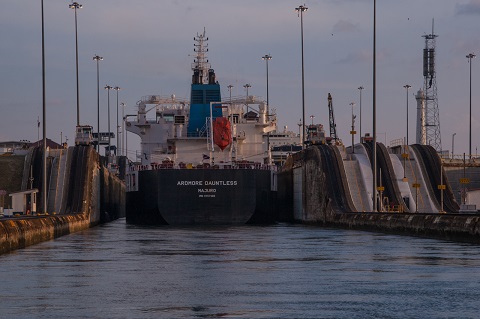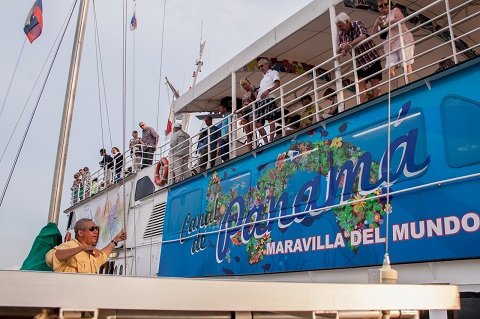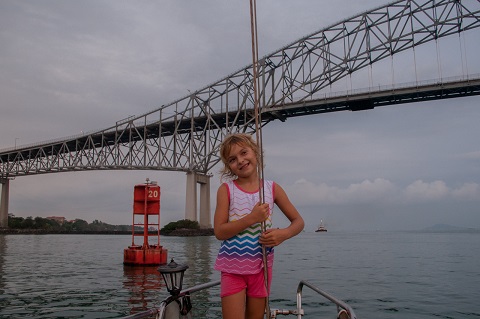
Sailing Vessel Beruta Ship's Log
Colon - Panama City. Panama Canal Transit

29 April 2016
A night before I was rereading some log books of other sailors about transiting the Panama Canal and found that a pilot may check the running lights. I flipped the breaker and... yes, the stern light did not come up. Tricolor on the mast, port and starboard bow lights and steaming one were working fine. I had checked them all before our departure from Curacao. The transit was scheduled at 17:00, so I had some time to do something.
Elvira went to Panama City to get the passports with French Polynesian visas and I with Masha took a taxi to couple of nearby marine stores, which mainly sell the fishing gear.
The first one, Abernati, located in Cuatros Altos, had no LED stern lights, so I bought the regular one for 37 dollars. The other shop, Max Industries in Millenium plaza where I had to buy the marine horn few days before, which was mandatory for passing the Canal, had no stern lights at all. The new light meant to be mounted through stern. My original LED was screwed to a plate on the pushpit. When we returned to the boat, I spent an hour or two trying to fit it to a new plate and protect from the water.


I picked Vitaly, a friend of mine from sailboat Attila and two line handlers that we hired from Mr. Tito from Club Nautico at 14:00. Tito delivered four heavy lines and six fenders made from old tires wrapped in plastic bags a day before. What I forgot to do, was to turn the radio on channel 12!
We left the Club Nautico anchorage at 16:00 heading towards Flats. Two other boats were already waiting there. When we were few cables from them, they suddenly ran full speed toward the Canal. At that point I recalled the radio and turned it on. Apparently, the Canal authorities had already been hailing Beruta for some time.
They inquired about our position and instructed to wait for a pilot there. In couple of minutes he boarded Beruta and we followed the other boats. It was 16:30 or half an hour earlier the scheduled time. Normally a pilot arrives an hour later.
In front of the first gate we moored starboard side to large Swedish catamaran who had Autralian sailboat on the other side. The crew of the cat did all the job. I only worked with an engine in forward or reverse and helping to steer the course but the rest of the crew were mostly resting occasionally making sure that our windpilot was not in a way of the mooring lines, which all went to the cat.
We had sandwiches along the way. Important point was to serve the pilot with unopened bottled water preferably cold.
Each chamber raised us about 10 meters of so. We were behind a big cargo chip all the time. When we finished, it was already dark. We anchored not far from the port side of the Canal in Gatun lake. The pilot left the boat. The second half of the transit would be next day. I took a brief swim in fresh water, Elvira too despite the warning about crocs. Our experienced local line handlers washed themselves in a backet saying that it was dangerous to swim in the lake. Vitaly did not wash himself at all creating unpleasant sweat odors in a cabin.
Elvira did her best to feed everyone with rise and a chicken that we had bought in Super 99 in the morning. Vitaly got drunk and tried very hard to drunken the rest of the crew despite my warnings.


30 April 2016
The night was hot because there was no wind. Four people slept inside and two lucky ones in the cockpit.
I woke up at 4:00, did yoga and washed the deck. Elvira prepared the breakfast. At 7:00 there was no sign of a pilot as expected. We waited one hour, then another. It was very hot and finally I decided to put a tent for a shadow. As soon as I did it, the pilot showed up. It was 10:00.
We motored across the lake. It was almost 30 miles to the next gate. The Australian boat went far ahead, then Beruta and the cat was the last one. The surrounding area was all nature, National Reserve. All the islands and the shore were green. No deforestation here. It was necessary to protect the Canal.
At some point, our pilot wanted to give a message to the pilot on the cat and asked me to slow down. After they had talked, the cat went ahead of us. An hour or so later, the authorities informed our pilot that there was another boat 6 miles behind us and asked us to wait for her. I reduced the speed from 6 knots to somewhere between 1 and 3. Another hour later, they told the pilot that we should have caught the other two boats that were waiting for us near the gate. I ran full speed ahead but we were late.
We slowed down to enter the chamber in the next 30 minutes when Beruta became occupied by huge amounts of  bees! They were everywhere, especially on the mast and rigging. It was raining and the bees were trying to make their house on our radar.
bees! They were everywhere, especially on the mast and rigging. It was raining and the bees were trying to make their house on our radar.

When we went inside and moored to a small charter ship, one of our crew missed a bee on the mooring line and got stung. Luckily he did not have an allergy, just the pain. The rest of the two gates we passed with this charter boat. The only difference was that we had to tie and untie the lines in each chamber.
In the last chamber the intake current was particularly strong and there was a minute of near collision with a wall on a portside and the charter boat on the starboard but we were lucky. I was working hard with the engine reversing and then forwarding trying to control Beruta and minimize the damage but the trick made a simple but tasty sandwich, which Elvira had given to the charter boat's Portugese pilot in the previous chamber and he had put a nice big fender along the board that saved us. Just few seconds of adrenaline - that was all.
As soon as we hit salt water of the Pacific the bees disappeared and we finally saw a crocodile! It was swimming along the shore of the canal. Ok, now we knew that they were for real!
The pilot disembarked under  the Las Americas bridge. It was dark again when we got a mooring buoy of Balboa Yacht Club, which was right after the bridge on the portside. I was asked to pay 12 dollars for the water taxi and 6 for disposing the fenders. I gave 20 to our line handlers but they still asked for a tip despite that we paid 100 dollars each. Later we found that the water taxi was free for mooring buoy renters which cost us 26 dollars for one night. Overall the Canal transit cost us over 1,700 dollars excluding the almost 1,000 deposit that would be refunded in 2-3 weeks. By doing it via agent, we saved 250 dollars on visas and cruising permit fees. Ask Mr. Tito for the details.
the Las Americas bridge. It was dark again when we got a mooring buoy of Balboa Yacht Club, which was right after the bridge on the portside. I was asked to pay 12 dollars for the water taxi and 6 for disposing the fenders. I gave 20 to our line handlers but they still asked for a tip despite that we paid 100 dollars each. Later we found that the water taxi was free for mooring buoy renters which cost us 26 dollars for one night. Overall the Canal transit cost us over 1,700 dollars excluding the almost 1,000 deposit that would be refunded in 2-3 weeks. By doing it via agent, we saved 250 dollars on visas and cruising permit fees. Ask Mr. Tito for the details.
All pictures from Panama are on Google Photos.


